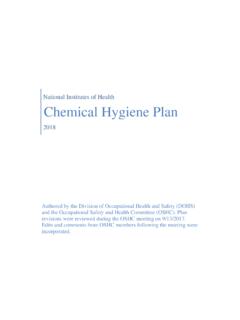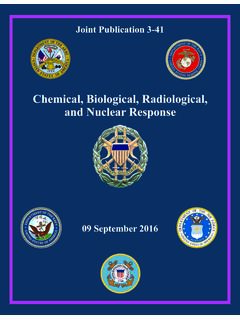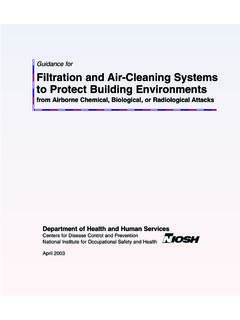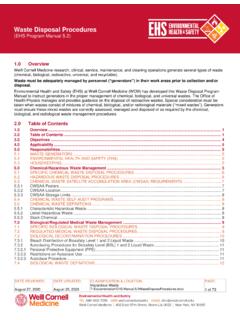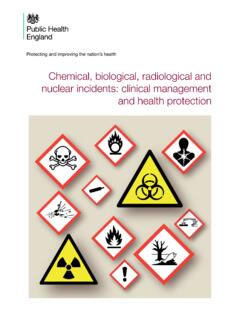Transcription of ATP 3-11.74 CHEMICAL, BIOLOGICAL, RADIOLOGICAL, AND ...
1 ATP chemical , biological , radiological , AND. nuclear PLATOONS. APRIL 2021. DISTRIBUTION RESTRICTION: Approved for public release; distribution is unlimited. Headquarters, Department of the Army Foreword As the chemical Corps enters its second century of service in the United States Army, it must adapt to new threats and overcome 15 years of atrophy of chemical , biological , radiological , and nuclear (CBRN) skills within the Army that were attributed to operations in counterinsurgency. Throughout that time, the chemical Corps approached the CBRN problem as it had for the past 100 years avoid, protect, and decontaminate.
2 These three insular capability areas provided a linear approach to detect existing hazards and offered a bypass of CBRN. obstacles to enable the safe passage of forces. The approach to the CBRN program remained slow to change, discounting new forms of battle being exercised and conducted by major regional players (Russia, China, Iran, and North Korea). The proliferation of new technologies, to include weapons of mass destruction (WMD). capabilities and materials, will remain a constant during the next 100 years.
3 The chemical Corps, in conjunction with the Army and joint force, must adapt and prepare for CBRN usage throughout the range of military operations . The chemical Corps exists to enable movement and maneuver to conduct large-scale ground combat operations in a CBRN environment. Friendly forces must retain freedom of action and be capable of employing the full breadth of capabilities within complex battlefield conditions, including CBRN environments. The latest addition of FM 3-11 ( chemical , biological , radiological , and nuclear operations ) outlines the core functions of Assess, Protect, and Mitigation with the integrating function of Hazard Awareness and Understanding to defeat pacing threats and near-peer adversaries in a contested CBRN environment.
4 ATP CBRN Platoons is a complementary publication that addresses tactical operations from a CBRN platoon perspective in support of decisive action. To support large-scale ground combat operations , the Army CBRN Regiment's platoons must be agile and adaptive, capable of employing their full capabilities to enable the Army to win in a complex CBRN environment. It is essential that CBRN platoons maintain operational readiness and CBRN mastery while supporting freedom of action for maneuver units. CBRN platoons must be integrated throughout tactical formations as a critical enabler to maintain overmatch in contested CBRN environments where adversaries will leverage weapons of mass destruction to establish and maintain a position of relative advantage.
5 ATP provides a thorough doctrinal approach for CBRN platoons at the tactical level of war to provide options for maneuver commanders. Most importantly, it provides CBRN company and platoon leadership doctrinal guidance to employ offensive and proactive CBRN capabilities to maintain force overmatch against our adversaries. Our CBRN platoons deserve the very best in agile and adaptive leadership that can support the friendly scheme of maneuver within the complex rigors of CBRN environments. ATP CBRN Platoons provides CBRN.
6 Platoon leaders and NCO leadership a doctrinal guideline to assess, protect, and mitigate CBRN threats while ensuring survivability in large-scale ground combat. DARYL O HOOD. BRIGADIER GENERAL. CBRN COMMANDANT. This publication is available at the Army Publishing Directorate site ( ), and the Central Army Registry site ( ). *ATP Army Techniques Publication Headquarters No. Department of the Army Washington, , 15 April 2021. chemical , biological , radiological , and nuclear Platoons Contents Page vii INTRODUCTION.
7 Viii Chapter 1 ROLE OF THE CBRN PLATOON .. 1-1. Section I Assess .. 1-1. Section II Protect .. 1-1. Section III Mitigate .. 1-1. Section IV Operational Environment .. 1-2. chemical Hazards .. 1-2. biological Hazards .. 1-2. radiological Hazards .. 1-2. nuclear Hazards .. 1-2. Unique Environment Considerations .. 1-2. Section V Key Personnel .. 1-4. Common Responsibilities .. 1-4. Platoon Leader .. 1-4. Platoon Sergeant .. 1-5. Squad Leader .. 1-5. Team Leader .. 1-6. Chapter 2 COMMAND AND CONTROL .. 2-1.
8 Section I Platoon Mission Command .. 2-1. Section II Troop Leading 2-5. Step 1. Receive the Mission .. 2-5. Step 2. Issue a Warning Order .. 2-6. Step 3. Make a Tentative Plan .. 2-7. Step 4. Initiate Movement .. 2-11. Step 5. Conduct Reconnaissance .. 2-11. Step 6. Complete the 2-12. Step 7. Issue the Order .. 2-12. Step 8. Supervise and Refine .. 2-13. Rehearsals .. 2-13. Methods of Rehearsals .. 2-14. Precombat Checks and Inspections .. 2-16. Section III Planning Considerations .. 2-16. DISTRIBUTION RESTRICTION: Authorized for public release; distribution is unlimited.
9 ATP i Contents Section IV Command and Support Relationships .. 2-17. Command Relationships .. 2-17. Support Relationships .. 2-18. Section V Orders, Briefings, and Reports .. 2-19. Orders .. 2-19. Briefings .. 2-19. Reports .. 2-21. Sustainment Reporting .. 2-24. Section VI - Graphic Control Measures .. 2-25. Section VII Communications .. 2-26. Section VIII Integration with Supported 2-27. Linkup .. 2-27. Execution .. 2-28. Chapter 3 PLATOON operations .. 3-1. Section I Battle Drills .. 3-1. React to Contact.
10 3-1. React to Indirect Fire .. 3-3. Break Contact .. 3-3. React to an Ambush Near .. 3-4. Evacuate a Casualty (Dismounted and Mounted) .. 3-4. Dismount a Wheeled Vehicle While Under Direct Fire .. 3-7. React to a Vehicle Rollover .. 3-8. Enter and Clear a Room .. 3-9. Section II Movement Techniques .. 3-11. Traveling .. 3-11. Traveling Overwatch .. 3-12. Bounding Overwatch .. 3-13. Section III Force Protection .. 3-15. Section IV Fire Support .. 3-16. Call for Fire .. 3-16. Six Elements of the Call For Fire.










